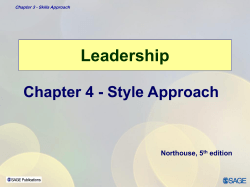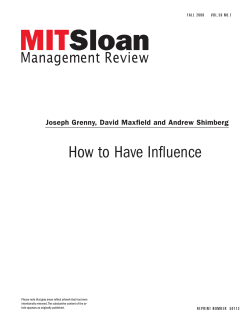
Recommended Practices Preventing Challenging Behavior in Young Children: Effective Practices
Recommended Practices www.challengingbehavior.org Preventing Challenging Behavior in Young Children: Effective Practices Peter J. Alter & Maureen A. Conroy “An ounce of prevention is worth a pound of cure.” Benjamin Franklin The single best way to address challenging behaviors in young children today is to take steps to make sure that they never occur. While there is no universal panacea for preventing challenging behaviors, there are several broad-based early intervention strategies that researchers suggest to prevent challenging behaviors. These strategies include: (a) arranging of the classroom environment, (b) scheduling, and (c) implementing rules, rituals, and routines. In the following section, a brief overview of each of these prevention strategies is provided. Effective Classroom Environments Effective classroom environments begin with a well-organized and engaging classroom that includes developmentally appropriate practices (DAP), activities, and materials. For instance, if the children in a classroom are engaged with interesting activities and materials that are appropriate for their developmental levels, they will be less likely to engage in challenging behaviors. On the other hand, if the activities and materials are too difficult or too easy, challenging behavior is more likely to occur. Consider the following points when designing a well-organized and effective classroom environment. Designing effective classroom environments includes structuring the physical arrangement of the classroom to increase appropriate behaviors, such as engagement, and decrease the probability of challenging behaviors. Several strategies for structuring the physical classroom include: arranging the classroom to ensure visual monitoring of children, arranging activity centers to support children’s appropriate behaviors (e.g., limiting the number of children in a center) and facilitating smooth transitions among activities (e.g., organizing the location of materials on shelves), and arranging materials in the classroom to promote engagement, mastery, and independence. Increasing the accessibility, appropriateness, and availability of toys and materials can facilitate children’s independence, thus, decreasing the likelihood of challenging behaviors. In addition, attending to details, such as the lighting, temperature, and noise levels, can reduce the probability of children who engage in problem behaviors due to sensitivity to these environmental factors (e.g., children with autism). Designing effective classroom environments also includes structuring the interpersonal climate of the classroom. When teachers attend to children’s appropriate behaviors and provide assistance as they need help, children are less likely to engage in challenging behaviors. Developing a positive interpersonal climate begins with implementing engaging activities that are developmentally and individually appropriate for all children. In addition, the use of positive attention and positive feedback with children who are engaging appropriately in activities and playing with their peers will increase appropriate behaviors. Remember, “catch them being good” and acknowledge them for it! References Bovey, T. & Strain, P. (2003). Using environmental strategies to promote social interactions. Center on the Social and Emotional Foundations for Early Learning. Retrieved September 6, 2005, from www.csefel.uiuc. edu/what works.html. Brown, W.H., Odom, S.L., & Conroy, M.A. (2001). An intervention hierarchy for promoting preschool children’s peer interactions in natural environments. Topics in Early Childhood Special Education, 21, 90 – 134. Center for Evidence-Based Practice website at http:// www.challengingbehavior.org Center on the Social and Emotional Foundations for Early Learning website at http://www.csefel.uiuc.edu Del’Homme, M., Kasari, C., Forness, S. R., & Bagley, R. (1996). Prereferral intervention and students at risk for emotional and behavioral disorders. Education and Treatment of Children, 19, 221-232. Gable, R. A. (2004). School-wide positive discipline. Richmond, VA: Virginia Department of Education. Hester, P.P., Baltodano, H.M., Hendrickson, J.M. Tonelson, S.W., Conroy, M.A., Gable, R.A. (2004). Lessons learned from research on early intervention: What teachers can do to prevent children’s behavior problems. Preventing School Failure, 49, 5-11. Kauffman, J. M. (1999). How we prevent prevention of emotional and behavioral disorders. Exceptional Children, 65, 448-468. Lawry, J., Danko, C., & Strain, P. (1999). Examining the role of the classroom environment in the prevention of problem behaviors. In S. Sandall & M. Ostrosky, (Eds.), Young exceptional children: Practical ideas for addressing challenging behaviors (pp. 49-62). Longmont, CO: Sopris West and Denver, CO: DEC. Massey, G.N. & Wheeler, J. J. (2000). Acquisition and generalization of activity schedules and their effects on task engagement in a young child with autism in an inclusive pre-school classroom. Education & Training in Mental Retardation & Developmental Disabilities, 35, 326-335. Continued on page 3... Scheduling Children like predictability! Creating and teaching the daily schedule helps communicate to the children the organization of daily activities and events. Providing a predictable daily schedule helps prevent the occurrence of challenging behavior. Therefore, designing effective classroom environments involves implementing consistent daily schedules. When implementing a daily schedule, consider the following points. Young children in particular may benefit from the use of photographic or picture schedules that provide concrete, visual cues of the scheduled activities and routines. In fact, children who are just beginning to learn language may actually need to have real objects included in their schedules. When organizing a daily schedule, teachers may want to consider rotating large and small group activities, varying active and quiet activities, structuring a transition time in the activity, and placing the most difficult activity at a time when the children are most alert and attentive. It can also help to include a schedule within activities as well as across activities. For instance, if the activity has several components, the teacher may want to communicate to the children what will come first, next, and so forth by showing the child a sequence of visual cues (e.g., photographs, line drawings) that represent the different components of the activity. Again, this will communicate to the child what to expect. Embedding choices within the schedule, in which children have an opportunity to decide between one activity and another (e.g., blocks center or dress up center) also will increase the rate of child engagement and decrease the likelihood of challenging behaviors. Rules, Rituals, and Routines A critical component of the environment that decreases the likelihood of challenging behaviors is providing rules, rituals, and routines. Rules are most appropriate for preschool age children; whereas, rituals and routines are more applicable to younger children. Providing rules, rituals, and routines helps provide structure for everyone in the classroom, including the adults. A ritual may be a song, a rhyme, a game, kinesthetic movement or any other activity that is used in a predictable and repeated pattern over time to communicate values, foster community, or remind children of behavioral expectations. When implementing rules, rituals, and routines, consider the following points. Rules provide preschoolers with the structure to teach them which behaviors are appropriate and which behaviors are not appropriate in the classroom setting. For younger children especially, rituals and routines provide verbal and non-verbal cues and prompts that help them learn appropriate behaviors. For example, a bell that signals the end of play time provides children with a cue about a schedule change and allows them to initiate the change without verbal prompting from the teacher. Rituals and routines may include songs, rhymes, games, and kinesthetic movement that can be used to foster community and serve as rule reminders. These activities taught over time and embedded as part of a daily schedule serve as reminders to children about appropriate behaviors in different classroom contexts. Rituals and routines provide stability and consistency and can communicate values such as friendship, caring, or responsibility. For instance, the teacher may teach a set of songs about these values that children sing at the end of circle time, or the class may always review the expectations when walking in a line to go from place to place. In addition, rituals can be an effective way to ease transitions, reducing the occurrence of challenging behavior that often happens when children transition from one activity to another. An example of a ritual that may help ease transitions and serve as a rule reminder when children are going to a place where they need to be quiet, such as the library, or when they are starting a quiet activity, such as naptime, is for the teacher to say to the class “Zip it, lock it, and put it in your pocket. “ The actions that accompany this request is for the children to zip an imaginary zipper over their lips (zip it); act as though they are turning a key at the end of the zipper (lock it), and put the imaginary key in their pocket (put it in your pocket). When implementing rules, rituals, and routines, teachers will typically need to teach them to the children in their class using small steps, paired with positive, specific feedback and repeated over time until all the children understand and are able to engage in the appropriate behaviors. In summary, preventing challenging behaviors before they occur is part of an effective early childhood classroom. Creating a well-designed classroom that is engaging and developmentally appropriate and implementing schedules, rules, rituals, and routines can help create a positive classroom communicating to children how to act appropriately. When children understand what is expected and are provided the opportunity and support to engage in appropriate behaviors, they are more likely to choose this behavior, reducing the likelihood of using challenging behaviors. Remember, “An ounce of prevention is worth a pound of cure.” References (continued) McCormick, L., Noonan, M., Ogata, V. & Heck, R.(2001). Co-teacher relationship and program quality: Implications for preparing teachers for inclusive preschool settings. Education & Training in Mental Retardation & Developmental Disabilities, 36, 119-132. Ostrosky, M.M., Jung, E.Y., Hemmeter, M.L., Thomas, D. (2003). Helping children make transitions between activities. Center on the Social and Emotional Foundations for Early Learning. Retrieved September 6, 2005, from www.csefel.uiuc.edu/what works.html. Murdick, N. L. Petch-Hogan, B. (1996). Inclusive classroom management: Using preintervention strategies. Intervention in School & Clinic, 31, 172-177. Ostrosky, M.M., Jung, E.Y., Hemmeter, M.L., Thomas, D. (2003). Helping children understand routines and schedules. Center on the Social and Emotional Foundations for Early Learning. Retrieved September 6, 2005, from www.csefel.uiuc.edu/what works.html. NICHD Early Child Care Research Network (July, 1999). Child outcomes when child care classes meet recommended standards for quality. American Journal of Public Health, 89, 1072-1077. Nordquist, V. M., Twardosz, S., & McEvoy, M. A. (1991). Effects of environmental reorganization in classrooms for children with autism. Journal of Early Intervention, 15 (2), 135-152. Odom, S.L., McConnell, S.R., & McEvoy, M.A. (1992) (Eds.), Social competence of young children with disabilities: Issues and strategies for intervention. Baltimore: Brookes. Ratcliff, N. (2001). Use the environment to prevent discipline problems and support learning. Young Children, 56 (5), 84-87. Serna, L., Nielsen, E., Lambros, K., & Forness, S. (2000). Primary prevention with children at risk for emotional or behavioral disorders: Data on a universal intervention for Head Start classrooms. Behavioral Disorders, 26, 70-84.
© Copyright 2025





















